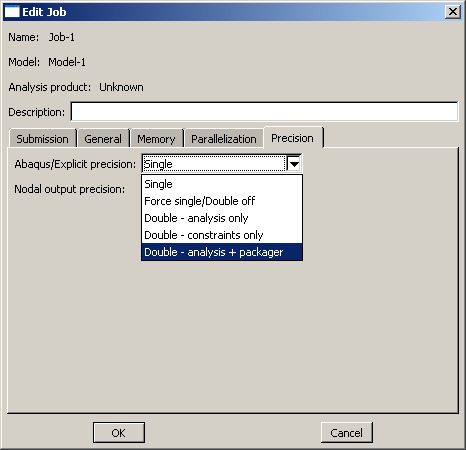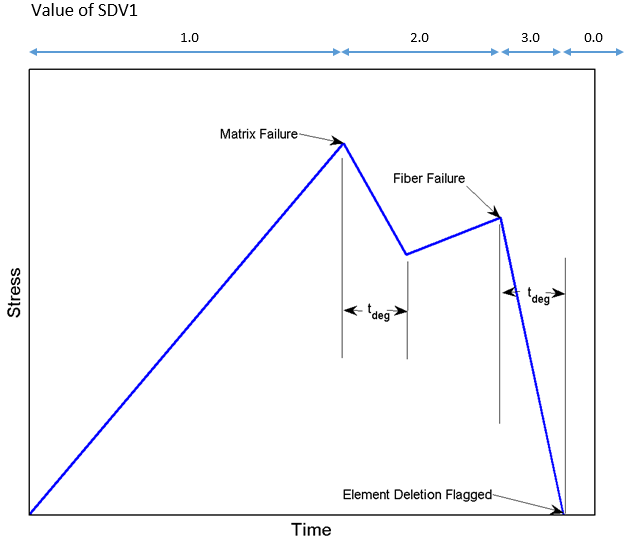View additional details pertaining to analyses using Abaqus/Explicit.
As previously mentioned, Helius PFA is compatible with both Abaqus/Standard and Abaqus/Explicit. In general, the specific requirements for Abaqus/Explicit are the same as Abaqus/Standard, however there are some aspects that are unique to Abaqus/Explicit and there are some features in Helius PFA that are not supported by Abaqus/Explicit. Although many of these aspects and restrictions have been discussed already, they are summarized and discussed here for completeness.
Execution
An analysis using Abaqus/Explicit is executed in the same manner as an analysis using Abaqus/Standard. Refer to the Installation and Operations Guide for more information on executing Helius PFA with Abaqus. The only difference to note is that Abaqus/Explicit allows you to select the amount of precision to use for numerical calculations (single or double precision). Helius PFA currently only supports double precision. The default method is single precision, therefore you must specify the double precision option. If the job is submitted from the command line you can use the 'double=both' or '-double both' option to specify a double precision analysis. For example:
abaqus job=explicit_job double=both
If the analysis is submitted from within Abaqus/CAE double precision can be selected under the "Precision" tab in the "Edit Job" dialog box. Choose the "Double - analysis + packager" option under the Abaqus/Explicit precision drop-down menu as shown below. This option can also be permanently set via the Abaqus environment file (abaqus_v6.env) by setting the double_precision variable to a value of BOTH.
Lastly, Helius PFA for Abaqus/Explicit only supports MPI based parallel execution methods on both Windows and Linux. Threaded parallel methods are not supported.

Material Definition Differences
In general, the definition of Helius PFA materials for Abaqus/Explicit is the same as Abaqus/Standard. The following is a list of the exceptions:
- The density of the material must be specified. For input files, this is done via the *DENSITY keyword and within Abaqus/CAE this is accomplished by selecting in the Edit Material dialog box.
- The number of required state dependent variables increased by six relative to the number required for Abaqus/Standard analyses. Refer to the flow-chart shown in the Request MCT State Variable Output for Composite Materials section to determine the precise value.
- If element deletion is desired, the DELETE parameter on the *DEPVAR keyword should be set to a value of 1. Within Abaqus/CAE, this can be set within the Edit Material dialog box by modifying the variable that controls element deletion for the Depvar Material Behavior.
- Certain analysis features are not supported (see below).
- There are additional material constants that can be defined that are unique to explicit analyses (see below).
Unsupported Analysis Features
The following material options are not supported for Helius PFA materials in an Abaqus/Explicit analysis:
- Helius PFA Cohesive materials
- Longitudinal shear nonlinearity of the matrix phase of a unidirectional composite (user material constant #4)
- Material strengthening from hydrostatic compressive loads in unidirectional composites (user material constant #6)
- Thermal residual stress calculations (*CURE STRESS keyword in HIN file)
- Output of constituent stresses and strains
- Damage tolerance (see Model Damage Tolerance in Composite Materials)
Explicit Specific Material Constants
There are three user-material constants that are specific to Helius PFA materials in an Abaqus/Explicit analysis:
- Material Degradation Time Period - UMC #11
- Matrix Strain Rate Strengthening Parameter - UMC #17
- Fiber Strain Rate Strengthening Parameter - UMC #18
Element Deletion
If desired, integration points can be deleted after ultimate failure of the composite material. Once all of the integration points in an element have been flagged for deletion the element will be permanently removed from the analysis. To turn on element deletion for a material set the DELETE parameter on the *DEPVAR keyword to a value of 1. For example:
*MATERIAL, NAME=IM7_8552 *USER MATERIAL, CONSTANTS=3 1, 1, 1 *DEPVAR, DELETE=1 12
An integration point is flagged for deletion anytime a fiber failure completes. Completion means that fiber failure initiates and the material has completely degraded linearly to its fiber failure state over the material time degradation period (see the image in Appendix A10). For woven composites a fiber failure in either tow will trigger element deletion regardless of the failure state of the other tow.
SDV1
The value of SDV1, the damage variable, behaves differently in Abaqus/Explicit analyses. Following a fiber failure event, the stiffness of the integration point is reduced to zero over some degradation time which is specified in UMC #11. After the degradation is complete, the value of SDV1 changes from 3.0 to 0.0.
| Value of SDV1 | Discrete Composite Damage State | |
|---|---|---|
| 1.0 | Undamaged Matrix, Undamaged Fiber | |
| 2.0 | Failed Matrix, Undamaged Fiber | |
| 3.0 | Failed Matrix, Failed Fiber | |
| 0.0 | Element stiffness reduced to zero after fiber failure and degradation time |
